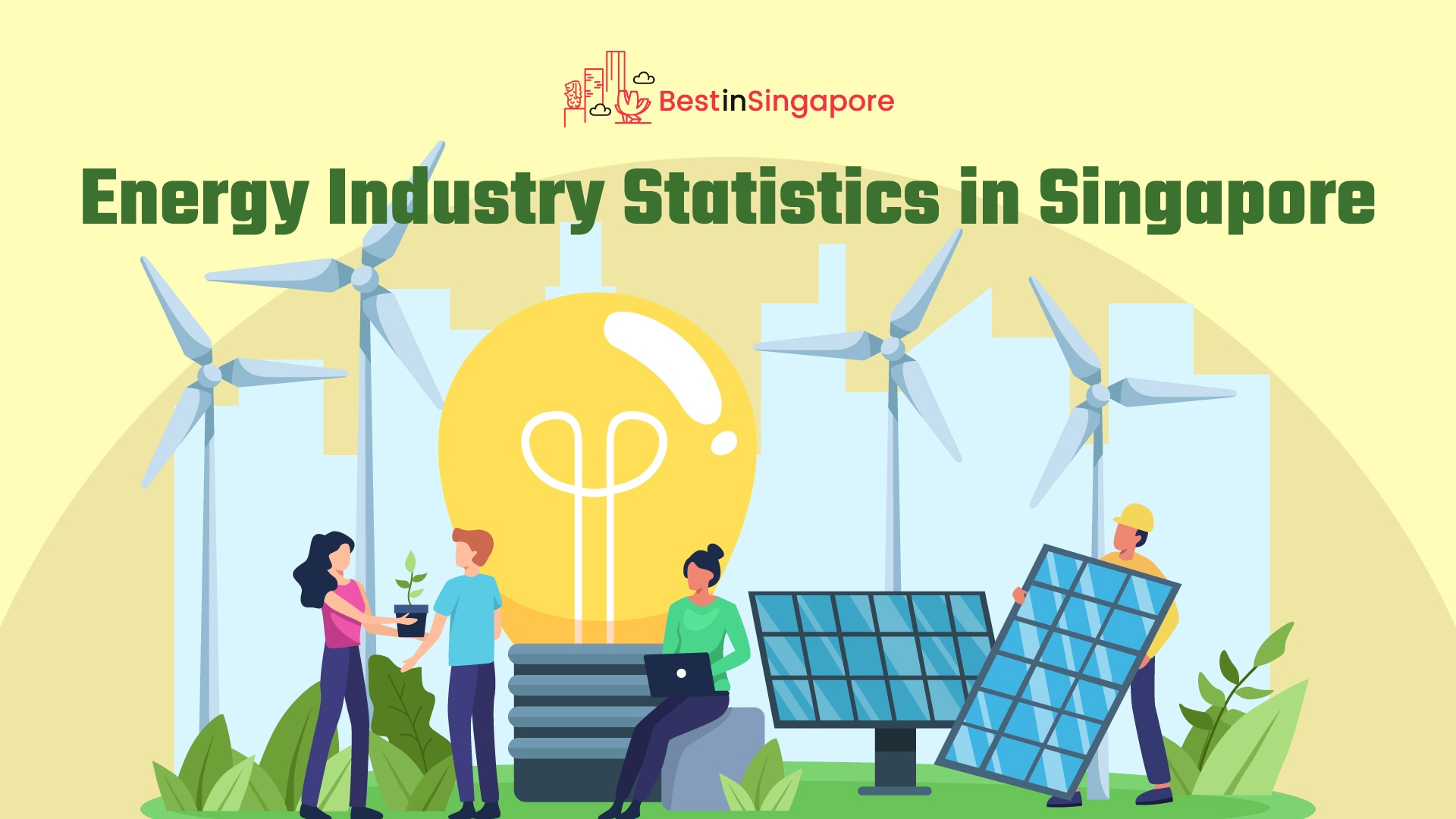A Statistical Overview of Singapore’s Energy Industry
Key Insights
⦁ Singapore has a registered energy generation capacity of 12.5 million kilowatts (kW). This resulted in a total of 53 billion kWh of electricity for 2020.
⦁ Of this 53 billion kWh of energy, 96% was contributed by natural gas generators, and only 0.2% was generated by petroleum products.
⦁ Following natural gas generators in energy contributions are coal and alternative energy at 1% and 2.8%, respectively.
⦁ To generate energy, the island relies on combined cycle gas turbines, steam turbines, open-cycle gas turbines, waste-to-energy plants, and solar photovoltaic systems.
⦁ From the island’s 12.5 million kW generation capacity, 83.4% comes from combined-cycle processes, 10.8% comes from steam turbines, 2.3% comes from solar PV systems, 2.1% comes from WTE plants, and 1.4% comes from open-cycle processes.
⦁ Compared to data from 2005, the use of petroleum product energy generators saw a significant 22.9% decrease in 2020.
⦁ In line with this, Singapore’s electricity grid emission factor saw a 77% decrease from 0.5255 kg CO2/kWh in 2005 to 0.4085 kg CO2/kWh in 2019.
⦁ For 2019, the industry sector consumed the most electricity at 21,444.5 GWh.
⦁ This figure represents a 147% increase from the industry sector’s 14,509 GWh energy consumption in 2005.
⦁ Following the industry sector in power consumption is the commercial sector at 19,315 GWh.
⦁ By 2030, Singapore hopes to achieve 2 GW of solar power and an energy storage deployment of 200 MW.
With an HDI index of 0.938, Singapore is one of the world’s most developed countries. This development can be seen in everything from retail applications, to waste management and even energy production.
To understand just how far Singapore’s energy industry, in particular, has come, one need only turn to statistics.
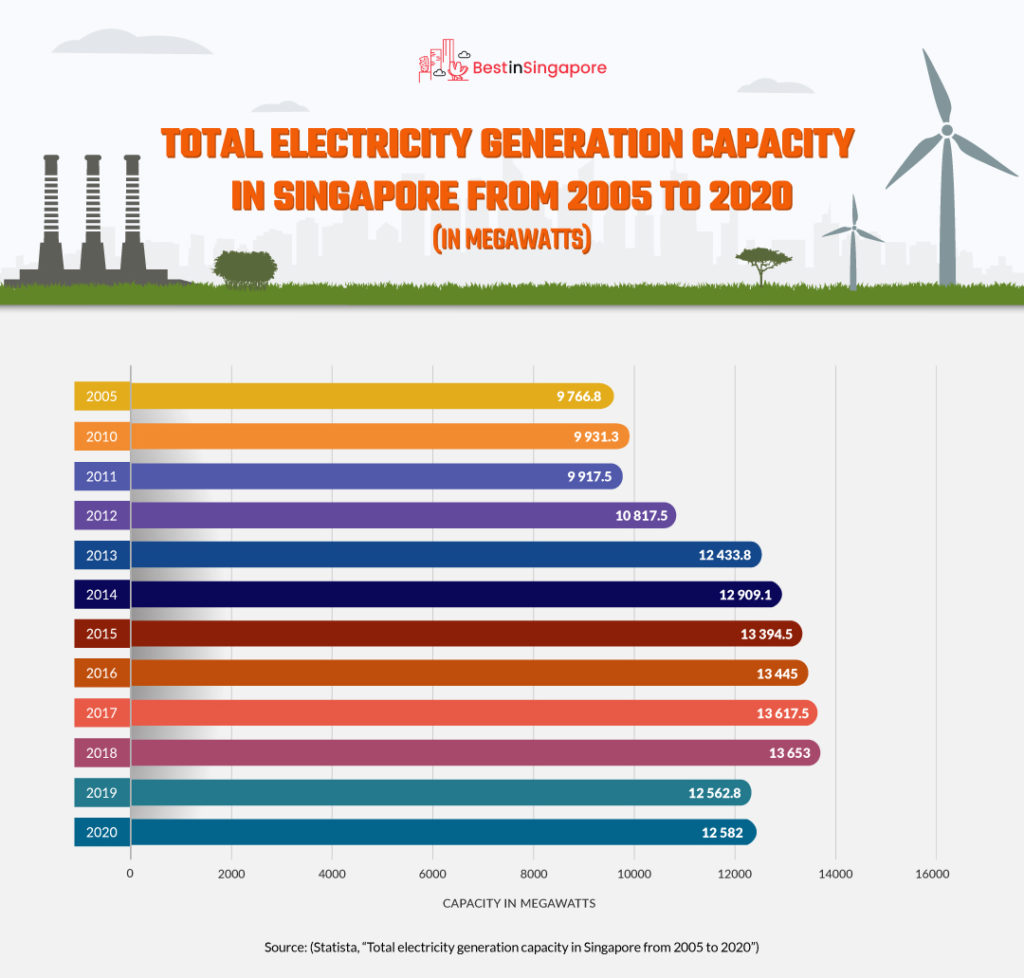
For the year 2020, Singapore’s energy generation capacity was rated at 12,582 megawatts (MW). This figure is leagues beyond what the nation was capable of in 2005 when the country could only generate 9,766.8 MW of energy.
Compared to current standards, this translates to a 128% increase in energy generation capacity from 2005 to 2020. Much of this development is due to the various alternative forms of power generation that the country has implemented over the years.
Now, based on the above figure, it is clear that Singapore’s generation capacity has decreased from an all-time high of 13,653 MW in 2018. With a difference of 1,071 MW, this is equivalent to a 7% drop in total generation capacity.
The reason for this drop was the decrease in consumer power demand due to COVID-19. With a lower need for energy, the island’s generation capacity was also decreased to preserve resources and avoid wasting electricity.
Recently, the power demand has begun to rise once again, as evidenced by the slight increase in generation capacity from 2019 to 2020. With this trend in mind, the Singaporean government has implemented various means to meet the fast-growing electricity demand.
As we explore these means, we will also delve into Singapore’s power sources, alternative energy systems, consumer energy usage, and future energy projects.
The Source of Singapore’s Power
To get a better sense of where a country stands in terms of energy production capabilities, it is best to examine that country’s energy balance. Generally, an energy balance is a direct comparison of a country’s energy demand and produced energy for a given year.
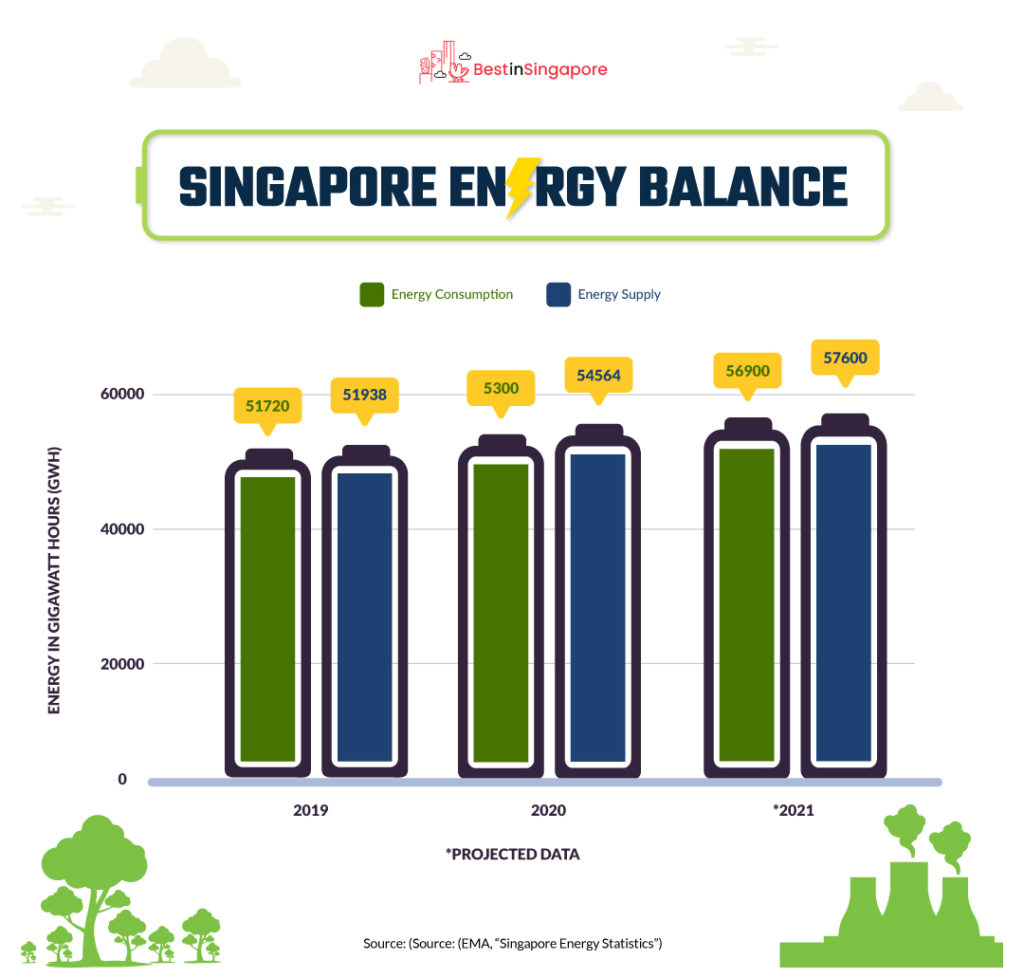
In 2019, Singapore recorded a total energy demand of 51,720 gigawatt-hours (GWh) and a net energy production of almost 52,000 GWh. If we analyze the same energy balance for 2020, we get a total energy consumption of 53,000 GWh and a net energy production of 54,564 GWh.
Though the data for 2021 is still incomplete we can certainly make use of energy projections. For this year, the country is expected to consume roughly 56,900 GWh and produce upwards of 57,600 GWh.
Given these totals, it’s apparent that Singapore can produce more than enough electricity to meet its energy needs. But to consistently accomplish this, the country relies on multiple energy generators.
These generators currently consist of combined-cycle gas turbines (CCGT), steam turbines, open-cycle gas turbines, waste-to-energy plants (WTE), & solar PV systems.
Among these generators, the biggest contributors by far are CCGTs.

To put things into perspective, from the previously mentioned 12,582 MW generation capacity, 10,491 MW are directly contributed by CCGTs. This is equivalent to an 83% contribution towards total generation capacity.
Following CCGTs as electricity generators, steam turbines are a second-place contributor at 10.8%. The 3 other sources are much closer together, with solar PV systems at 2.3%, WTE plants at 2.1%, and open-cycle turbines at 1.4%.
CCGTs provide so much energy because they are extremely efficient. This is due to a combined energy production process that uses natural gas as the main fuel source to power a turbine while simultaneously venting steam to a secondary turbine.
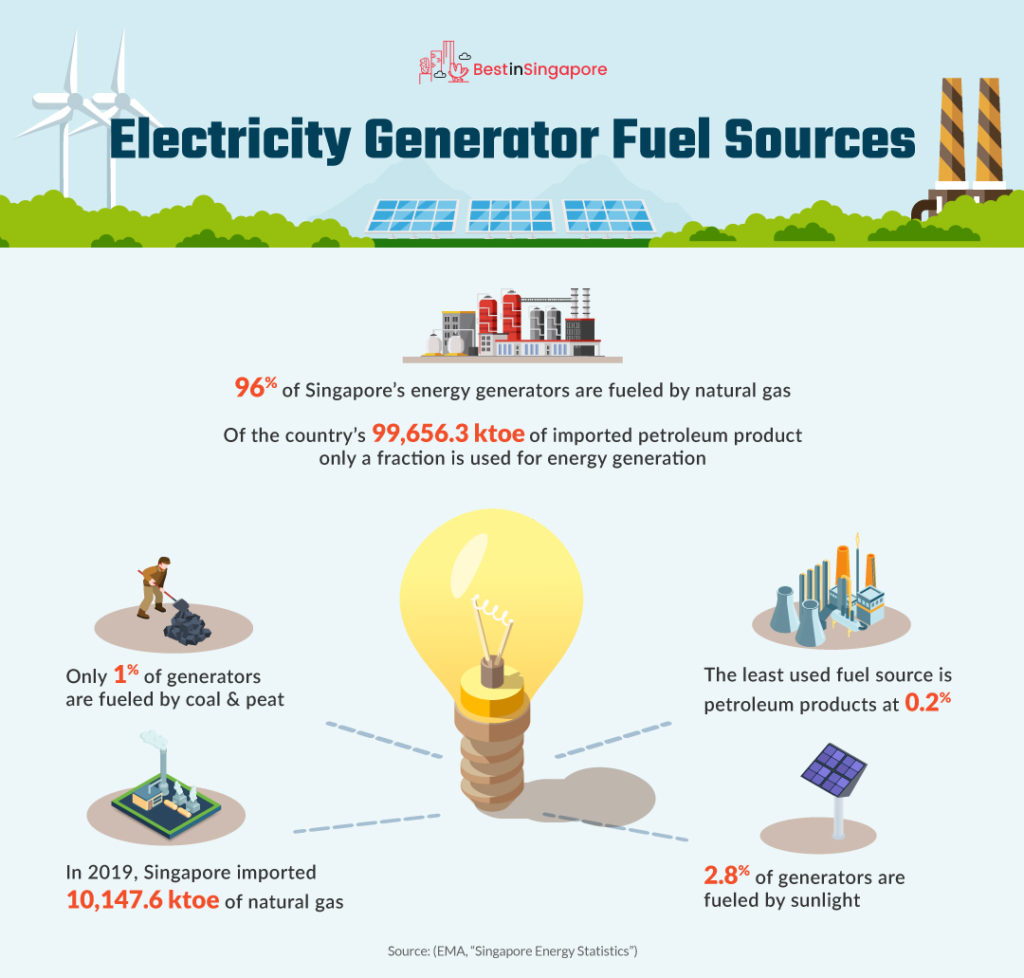
Since Singapore’s primary power generators run on natural gas, the country imports the resource heavily in its liquid form. In 2019 alone, the country imported a whopping 10,147.6 kilotonnes of oil equivalent (ktoe) of natural gas.
Aside from natural gas, the island also imports other resources such as petroleum products and coal for use in energy production. For 2019, Singapore imported 99,656.3 ktoe of petroleum products and 458 ktoe of coal.
Despite the country importing a larger volume of petroleum products, only a fraction of that is used in the production of energy. As far as fuel for electricity generation goes, natural gas is still dominant, with 96% of generators being fueled by it.
Interestingly enough, the second-most-used generator fuel is neither coal nor petroleum. Powering 2.8% of all generators, sunlight and renewable resources qualify as Singapore’s second-most-used fuels.
Sitting at a minuscule 1% and 0.2% are coal and petroleum products, respectively. Though the latter saw significant use in the early 2000s, it has since been replaced by renewable energy sources.
Singapore’s Shift to Greener Energy Practices
With the rise of renewable energy in Singapore, the country has seen many major changes in energy production. In terms of carbon emissions and general carbon footprint, the country has minimized these factors to a significant degree.
But, this wasn’t always the case as in 2005 the country’s electricity grid emission factor sat at 0.5255 kg CO2/kWh. While not extremely high, this level of emissions is considered extremely unsustainable based on present standards.
As a means of comparison, one can look to Bahrain, a country that is around 60 km^2 larger than Singapore. Bahrain ranks close to Singapore on the Human Development Index with a value of .852 and in 2018 Bahrain reported an emission factor of 0.633 kg CO2/kWh.
Despite having a much smaller population, Bahrain’s 2018 emission factor was still much higher than Singapore’s in 2005. This difference in emissions is largely due to Singapore’s focus on renewable energy sources.
To promote greener energy production, the government elected to shift from using petroleum products to natural gas for energy production. As a result, the country’s emission factor showed a decreasing trend alongside the lower usage of petroleum product fuel.
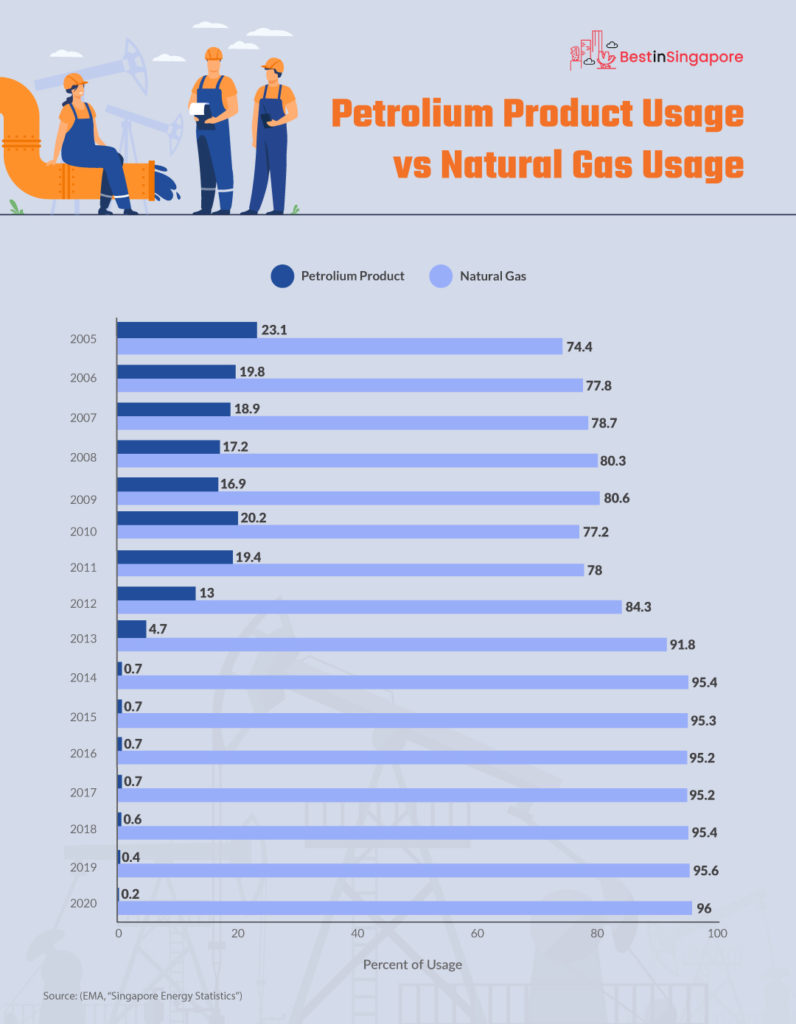

Thanks to the government’s efforts to minimize emissions, Singapore’s electricity grid emission factor saw a 77% decrease going from 0.5255 kg CO2/kWh in 2005, to 0.4085 kg CO2/kWh in 2019.
To see just how big an impact petroleum products can truly make, one need only look to the data for 2010 and 2011. During these two years, Singapore saw a spike in the use of petroleum products from 16% in 2009 to 20.2% and 19.4% in 2010 and 2011, respectively.
Following this spike in usage, the country’s emission factor climbed significantly, showing a 102% increase from 2009’s emission levels.
However, the spike only lasted up until 2012, after which usage dipped to 13%, thus continuing the downward trend.
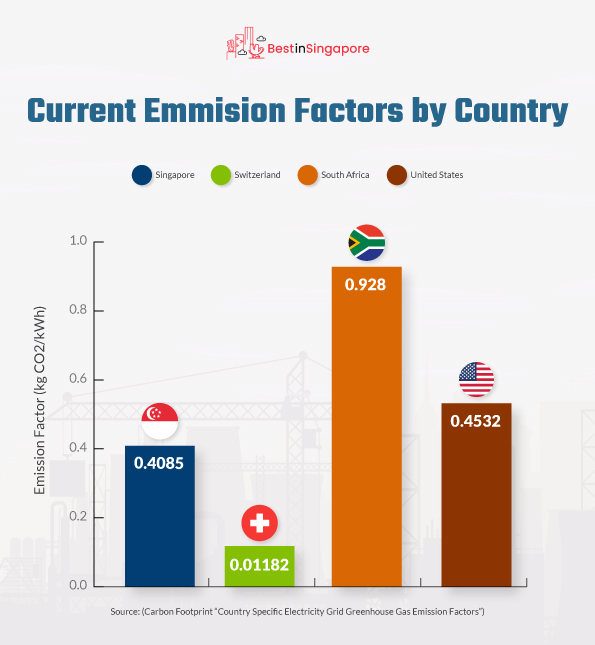
As a means of reference, in today’s conditions, the country with the lowest emission factor is currently Switzerland with a factor of 0.01182 kg CO2/kWh. On the higher end of the spectrum is South Africa with a factor of 0.928 kg CO2/kWh.
Though size can certainly play a factor in a country’s emission factor, technological development and energy production practices also play a significant role. As proof of this, the United States has an emission factor of 0.4532 kg CO2/kWh.
Despite being thousands of times larger, the U.S. still maintains an emission factor that is almost on par with Singapore. If emission reduction practices continue, the Garden City may possibly see even lower emission factors in the future.
To further supplement the shift towards green renewable energy, Singapore has enhanced its solar photovoltaic energy systems. From 2008, the number of solar PV installations began to soar.
Starting with a measly 30 installations in 2008, the country began creating more and more solar energy systems. By 2020, the number of installations turned to 4,168 in both the residential and commercial sectors.
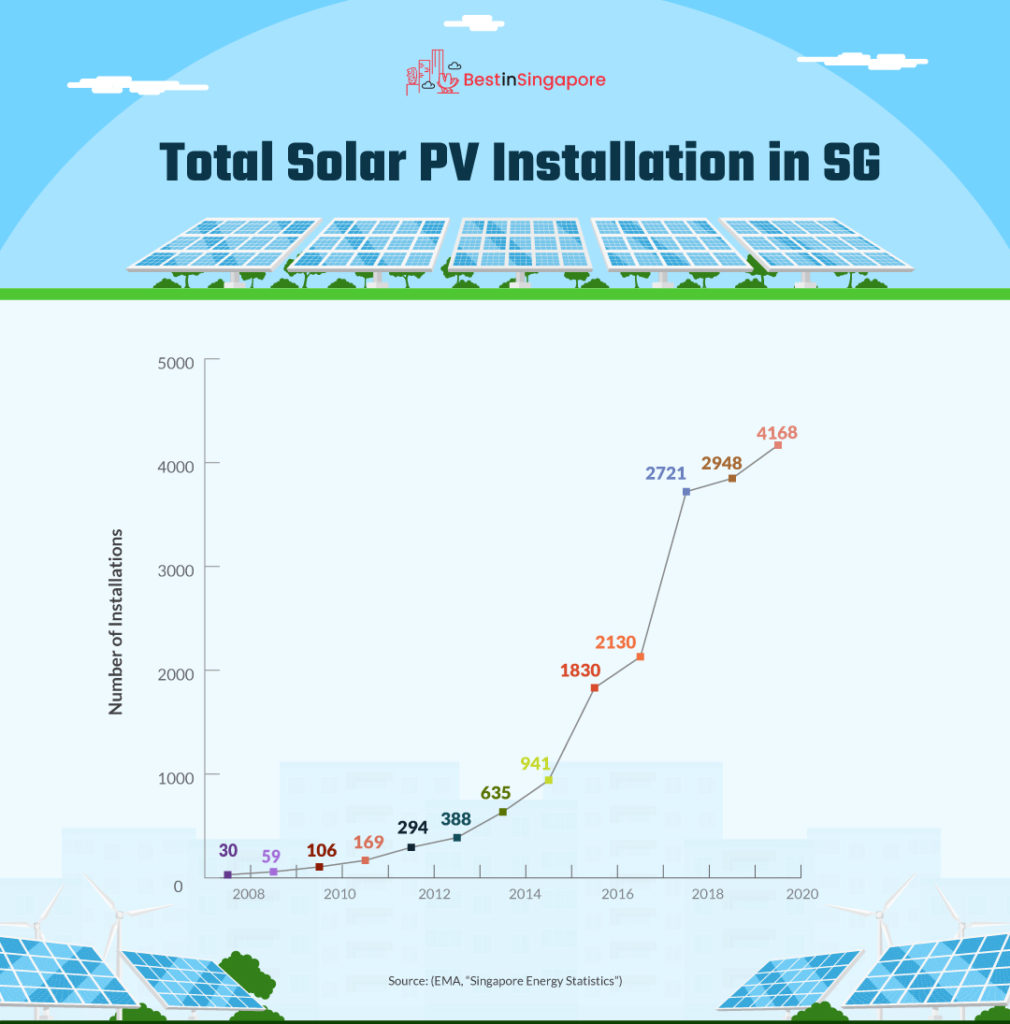
Of the 4,168 installations in Singapore, 53.2% belong to town councils and local government bodies. At a smaller percentage, 32% of the total installations belong to the residential sector.
The other 14.8% of installations are spread out among public service agencies and the private sector. The reason most installations belong to local government units is that the national government is the main proponent of expanding solar installations.
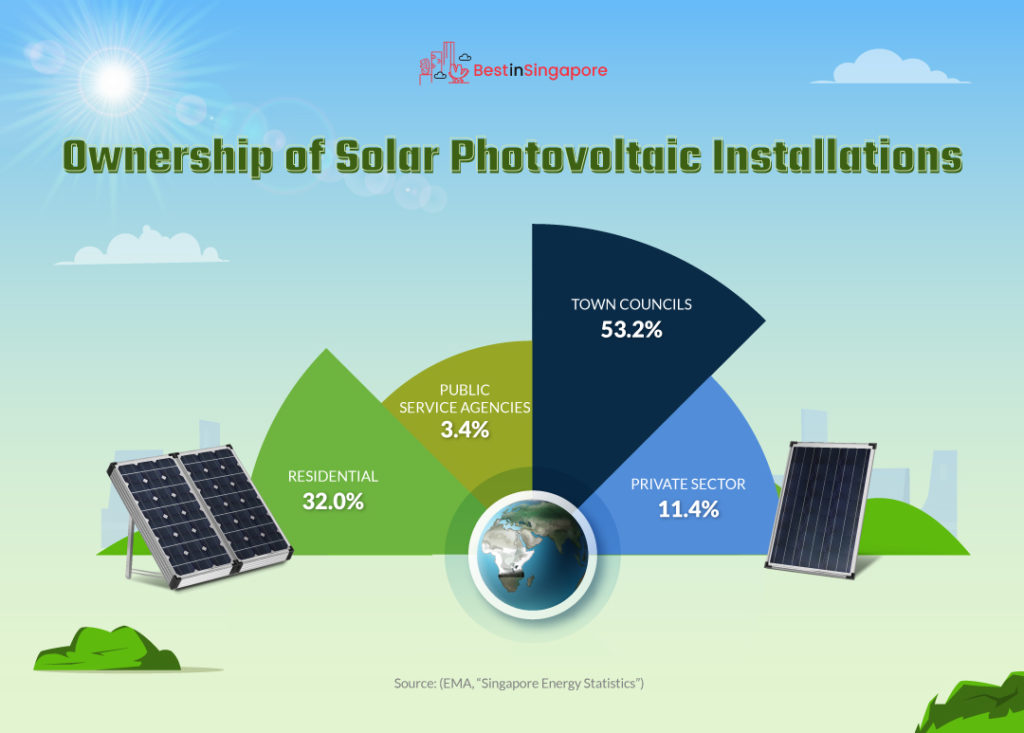
Collectively, Singapore’s solar energy grid can produce 388.2 MW at peak output. While this is relatively small compared to the country’s power demand, it is promising proof of the government’s successful renewable energy efforts.
Singapore’s Energy Consumers
Energy demand in Singapore has grown substantially. To date, there are over 1.6 million electricity accounts actively consuming energy in the country.
Of these 1.6 million electricity accounts, 89.5% belong to Singaporean households. This translates to over 1.48 million homes, which is 1.3 times the number of household electricity accounts in 2005.
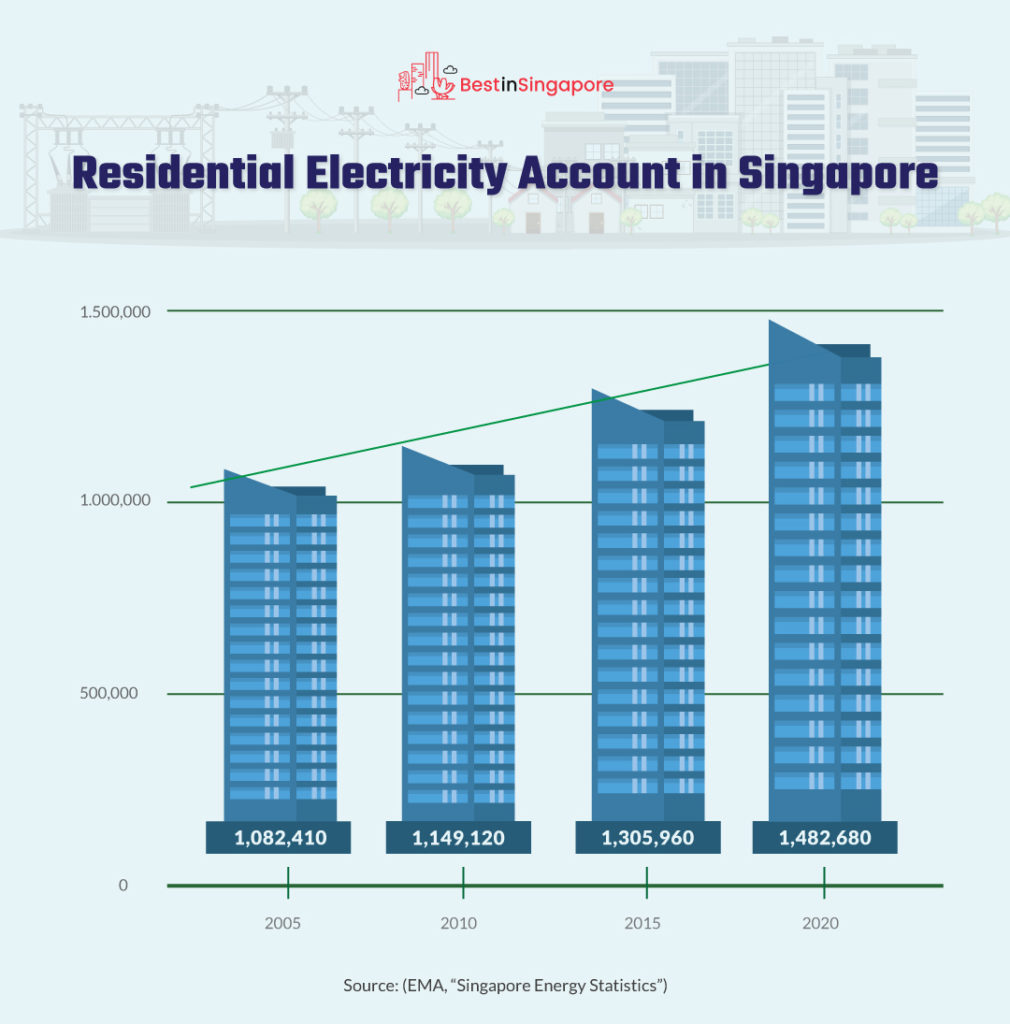
Since 2005, the number of accounts has steadily increased with each consecutive year. Understandably, this is a direct result of Singapore’s growing population, which results in a higher overall demand for energy.
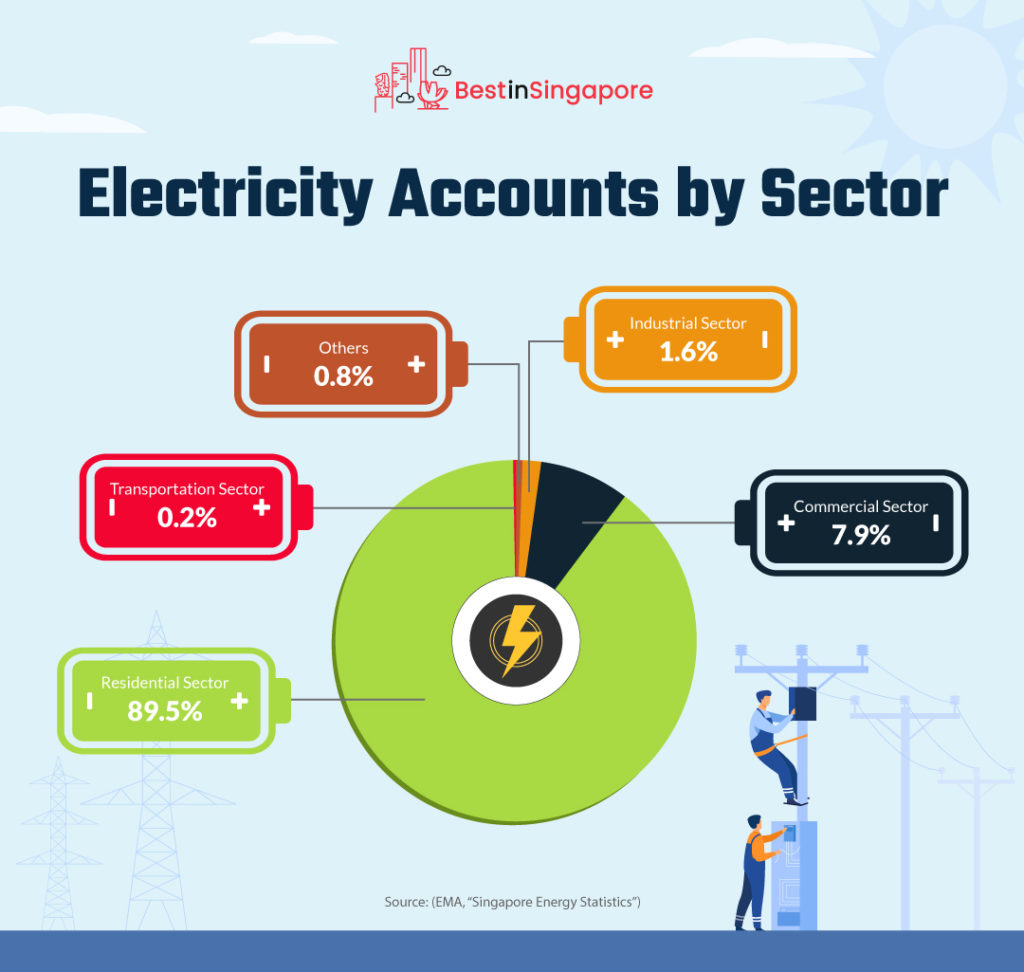
The rest of Singapore’s electricity accounts are spread out among various sectors, including the industrial sector, commercial sector, and transportation sector. It is worth noting that households are only the third-highest consumers of electricity despite having the most accounts.
The sector that consumes the most electricity is actually the industrial sector. In 2019, this sector consumed 21,444.5 GWh of energy. Following suit was the commercial sector with a recorded consumption of 19,315 GWh of energy.
Upon combining these figures with the respective consumption for all other sectors, Singapore’s total consumption comes out to 51,720 GWh of electricity. As the country’s development continues, the total consumption is expected to rise consistently.
Though figures are not yet available for each specific sector’s consumption in 2020, the total electricity consumed has already surpassed that of 2019.

Much of the industrial sector’s consumption in particular has to do with the manufacturing of various products such as electronics and chemicals.
One especially energy-intensive manufacturing process is that of water desalination. Among Singapore’s 4 national taps, this particular process is the most costly in terms of overall yield vs cost.
At current standards, this process uses about 3.5 kWh/m3 of energy to produce clean drinking water. With 3 plants currently in operating condition, water desalination can meet up to 30% of Singapore’s current water demand but it takes quite a bit of energy.
Since a 4th desalination plant will be built within the year, the manufacturing subsector’s energy consumption is expected to rise even further. To reduce the strain on the nation’s energy grid, researchers are currently searching for ways to make desalination more efficient.
In a miniature plant, it was demonstrated that desalination energy costs could be cut down to 1.65 kWh/m3. Researchers hope to continue cutting energy costs down to 1.5 kWh/m3, and eventually even 1 kWh/m3 in the future.
With higher energy demand, Singapore will face serious challenges to ensure green energy practices while also ramping up overall energy production. If the country is to succeed in meeting these challenges it must look towards renewable energy sources.
The Future of Singapore’s Energy Industry
In a nutshell, Singapore was previously heavily reliant on imported fuel such as natural gas for energy production. While this is still technically the case, the country has shown a strong collective effort to finance and promote clean energy production.
Aside from expanding its renewable energy systems, Singapore has to also cut down on the use of fossil fuels. As further evidence of the country’s support for renewable energy, All Singaporean banks have refused to finance the creation of coal-fired power plants.
Ultimately, the country aims to increase its solar power output to 2 GW while also increasing its overall energy deployment to 200 MW by 2030. In pursuing these goals, many citizens living in the rural countryside will also gain access to electricity.
By creating various rural solar PV systems, various towns outside of the city proper can have a localized energy grid that is completely green. Though this particular goal is still far from complete, the country’s efforts show much promise for a brighter, greener, more efficient energy industry.
A Real-world Perspective on Singapore’s Energy Statistics
⦁ Burning just 1 kilogram of coal is enough to produce 2.42kg of carbon dioxide.
⦁ 1 GW is enough to power more than 10 million light bulbs or 750,000 homes.
⦁ Producing 1 GW-hour of renewable energy in a year would require the equivalent area of almost 2 football pitches of solar panels.
⦁ In 2020 Singapore could generate over 12.5 GW of electricity. Since the average electricity in a bolt of lightning is about 9 GW, this translates to roughly one and a half bolts of lightning.
Sources:
⦁ Ning, T. S. (2021, August 28). Green energy: Shifting from fossil fuels to sun, wind & water. Retrieved from https://www.straitstimes.com/singapore/environment/green-energy-shifting-from-fossil-fuels-to-sun-wind-water#:~:text= In Singapore, the Government plans, and 5 GWp by 2050.
⦁ Singapore Electricity Production. (n.d.). Retrieved from https://www.ceicdata.com/en/indicator/singapore/electricity-production
⦁ Singapore Energy Statistics. (n.d.). Retrieved from https://www.ema.gov.sg/Singapore_Energy_Statistics.aspx
⦁ Singapore’s Energy Story. (n.d.). Retrieved from https://www.ema.gov.sg/ourenergystory

